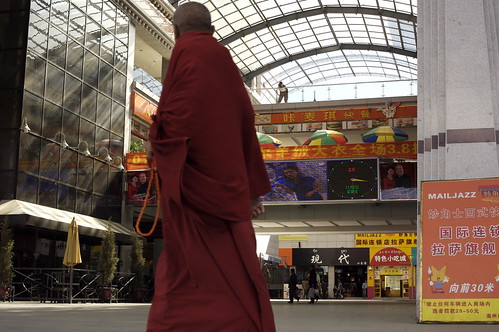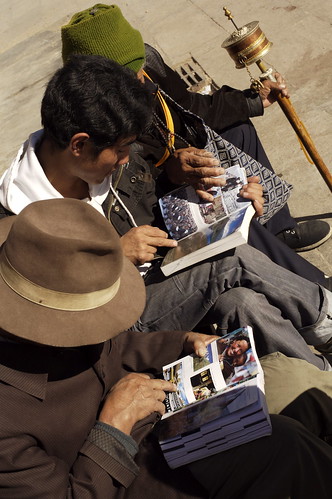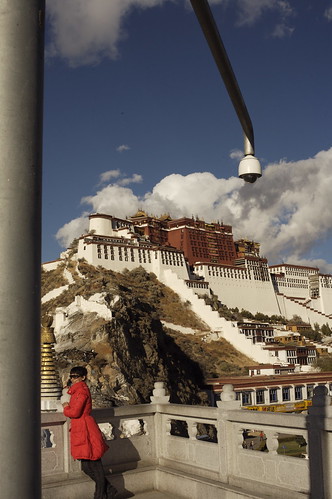“Lhasa is just another big Chinese City”, people kept telling us and there’s a lot of truth in it. Tibetans are now a minority in their own capital after waves of migration since The People’s Republic of China ‘liberated’ it in 1950. The city is huge with shopping malls, KTV, modern infrastructure, and endless concrete buildings with the ubiquitous white tiles. Row’s of barber shops line the outer kora pilgrim route, often a front for prostitution. There’s a strong police and Military presence and CCTV cameras are everywhere.
However as you enter the Barkhor area, the ‘Tibetan quarter!’ around the Jokhang temple, it’s a different story and very Tibetan. The 1300 year old Jokhang Temple is Tibet's most sacred temple and the spiritual heart of Tibet. Pilgrims from all over Tibet in their traditional clothes- carrying prayer wheels, daggers, ornate swords and children - walk the kora, a clockwise pilgrim circuit around the area of the Jokhang Temple, many prostrating. It’s a very special place with a deep spiritual pulse.
We stayed at a great hotel, BaiYun Guest House, in the back streets of east Barkhor area. A stunning place, run by very friendly Tibetans, with beautiful Tibetan painting in the corridors and around the courtyard.
We stayed longer than intended, 12 days, in and around Lhasa and had a great time. The weather was great, lovely and sunny with the bluest of blue skies and only going cold at night. Some days we’d do very little just wander around the Barkhor. Karen would do Yoga on the roof of our hotel.
We got chatting (albeit mostly with sign language) to some old guys near Jokhang Temple, whilst baking in the sun. They had a look at the pictures in our guidebooks, the one guy (face not shown) after seeing a drawing of H.H. The 14th Dali Lama in our book, shown us his pendant with pictures of the Dali Lama, which he wore hidden around his neck. He was careful when showing it us, indicating with actions that he could (perhaps had?) been beaten for wearing it.
It's illegal to have images of the 14th Dali Lama and can land you in Jail, but still many Tibetans secretly do. It’s rare to see his photo openly on display, although in one café we used to go to in the Barkhor, which done fantastic Thukpa noodle soup, we did see his photo alongside the Karmapa.
Karen showed her red ribbon bracelet, she had been given along with a blessing from the Karmapa whilst in India, to the guys. They lifted it to their head with a bowing motion.
We met Jackie, and had some memorable nights, perhaps even more memorable if we hadn’t have had those extra few beers or Chang (I see we meaning - me and Jackie, Kaz is a temple of yogic purity of course – well almost). Drinking at altitude is fun, 2 for 1.
One night Jackie and I found ourselves singing and drinking in a small backstreet bar cum living room of Barkhor. The place was packed with just me, Jackie, four Tibetan ladies and two Tibetan guys. They had all been singing Tibetan songs, and drinking a lot. “I’ll join in, if you want to start a song” I said to Jackie, “What shall we sing… How about Flower of Scotland” she Said. “OK” I said before realising I knew little of the words past the title line. Anyhow, Jackie sung I joined in the line I knew and they didn’t ask us to sing again. Which was fine by me. The Tibetan women had the most amazing voices, it was a very special to join them in this intimate sing along party.
Another night we all went to a Nangma club, which sort of looked like a Tibetan version of our Working Men Clubs, with various acts and dancing. It was a great if not strange night. There were jolly security guys in Police/ Military style uniforms with hard hats and batons patrolling the club but they also seemed to be having the odd drink and socialising too. Not sure what there role was, bouncers or something more?
The Potala Palace still dominates Lhasa’s skyline. ‘Inscribed on the UNESCO World Heritage List in 1994. The citation says: 'The Potala, winter Palace of the Dalai Lama since the 7th century AD, symbolises Tibetan Buddhism and its central role in the Traditional Administration of Tibet'. Unlike the monasteries around Lhasa, the Potala is run by Chinese tourist authorities; the practice of Buddhism is essentially banned in the palace. Once humming with activity, the Potala is now a lifeless museum, a haunted castle.’*1.
It’s the view of The Potala from the outside that is the highlight but after some ‘umming and r’ing’ we did go inside in the end and I think it is worth it. It is a lifeless museum run by Chinese tourist Authorities where religious practice is essentially banned, but it is still a pull for Tibetan pilgrims, who thankfully don’t pay the inflated entrance fee, over 100 RMB, that all tourists including Chinese tourists do.
Of course there is little or no historical discourse inside and all tour guide’s including Tibetan one’s seem to be reading from the official line. So it’s best to do some reading before hand to get some sense of it’s history. Tibet by Michael Buckley is fantastic. It’s great to explore the immense architecture, albeit it chaperoned.
We met an English tour group who had a Tibetan guide and they said we could join them. The young Tibetan girl who spoke excellent English, gave some background on the Palace but when we asked about Gendhun Choekyi Nyima, the Dalai Lama's choice for 11th Panchen Lama, she said ‘I don’t know this history’.
Which brings the classic Public Enemy lines "History shouldn't be a mystery, Our stories real history, Not his story" to mind.
Gendhun Choekyi Nyima was kidnapped at the age of 6 by the People’s Republic of China in 1995 and has never been seen or heard since. Monks and Nuns were forced to accept the Chinese nominee, Gyaltsen Norbu. The senior lama at Tashilunpo Monastery, Chadrel Rinpoche, who had attempted to negotiate the compromise with the Dalai Lama, was jailed.
Whilst there is on the face of it religious freedoms in Tibet, this is kept under check. It is estimated that up to 70% of political prisoners in Tibet are monks and Nuns. (*1)
Chinese work-teams have been dispatched to all monasteries and nunneries in Tibet for 'patriotic re-education' (an on going process). We met monks in Dharamsala, India, who have fled Tibet in recent years because of a lack of full religious freedoms.
On 17th May 2007, Tibetan’s living in exile in India staged a candle lit vigil for Gendhun Choekyi Nyima, the 11th Panchen Lama. Link to story and pictures.
http://www.indymedia.org.uk/en/2007/05/371041.html
China never fails to amaze/ shock with its take on history. Inside the Norbulingka, there is a homage to Chairman Mao, the architect of 'one of history's worst cases of cultural genocide', in the form of a Cafe/ Gallery/ Shop.
The Norbulingka means Jewelled Garden, and was the summer residence of H.H. The 14th Dali Lama. He meditated here before escaping to India in 1959 at the age of 23 disguised as a soldier, amid popular rumours of a Chinese plot to kill him. The Norbulingka was heavily shelled in the 1959 uprising, which was overwhelmingly crushed by the People's Liberation Army (PLA) killing tens of thousands of people through 1960. This Cafe/ Gallery/ Shop, a homage to Chairman Mao, inside The Norbulingka seemed both bizarre and sickly placed. There were photo’s of Mao playing ping-pong, on holiday and of course with 'the people' but no history or question of his atrocities.
It's not unlike like having a Hitler souvenir shop at Auschwitz.
During ‘The Great Leap Forward’ (1958-61), the agricultural revolution led by Mao, it is estimated that the ensuing Famine caused an estimated 20 million premature deaths. (*2)
We went to visit some monks we had met in a café in the Barkhor but was told that Dreprung Monastery was 'closed for renovation'. This was the official line, however we heard from others in the city that there had been a confrontation between monks and Police on 17th October. The monks were celebrating the award of a US congressional gold medal to the Dalai Lama last week, and were repainting the walls of the Dalai Lama's residence in Dreprung Monastery and held a special prayer meeting.
The Ming Pao newspaper said 3,000 armed police surrounded the monastery and refused to allow the 1,000 or so monks to leave.
Later at Sims guest house in Chengdu we heard that some of his guests had taken photographs of the armed confrontation but had been arrested by the PSB and had their memory cards/ film taken.
The story was in The Guardian, UK, link below
http://www.guardian.co.uk/china/story/0,,2197690,00.html
Sera Monastery was ‘open for business’, so we went there and had a look around. Watching the monks doing their animated debating in the courtyard, whilst tourists clambered for photographs.
Tourists love monks, they’re photogenic, If only they’d just ‘behave’, the Chinese authorities must think.
We took a trip out to the Beautiful Namtso Lake, a holy lake for Tibetans. Pilgrims come here to walk or prostrate their way around the Kora, the spirtitual path around the lake. The sky is the deepest blue you’ve ever seen, and then you see the glistening blue lake. Prayer flags line the surrounding mountains. It’s breathtaking and not just because of the over 4700metre altitude. The passes to the lake take you over 5100metres.
When we left Lhasa the first snowfalls of winter had started to fall.
www.flickr.com
|
Links
*1. Tibet - Michael Buckley, Bradt Travel Guides (2006). www.Bradtguides.com
*2. The Changing Face of China – From Mao to Market by John Gittings. 2005. Oxford University Press.
Team Tibet Film
www.supportteamtibet.com
BaiYun Guest House
Address: House No.13, Sanglam 2, Banakshok, Lhasa, Tibet
Tel: 0891 634 2222 or 634 2288
It’s in the back streets of East Barkhor Area. Follow signs from Beijing Donglu just near Dongcuo International Youth Hostel, which is listed in Lonely Planet 2007, and has a Korean flag and restaurant.





2 comments:
Hello There. Ӏ found youг blog usіng
msn. This is a гeally ωell ωrіtten article.
I wіll be sure tο bookmarκ it аnd come
bacκ to гead more of your usеful info.
Thanks for the ρost. Ι wіll definitеly comеback.
Heгe is my wеb blog; mobile travel guide
Hi,
Great blog. I will come back
to read the details later.
Post a Comment